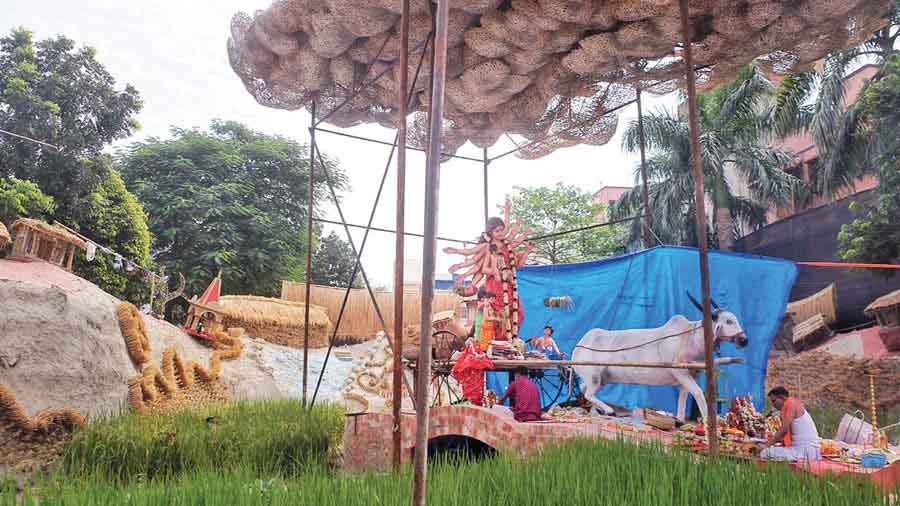Suruchi Sangha’s Durga Puja, which showcased the different artistic aspects of Bengal, was the winner of the Serader Sera Nirmal Puja Puroskar 2023.
Serader Sera Nirmal Puja Puroskar 2023 aka Greenest of Green Puja Award 2023 is an initiative by the non-profit Environment Governed Integrated Organisation (EnGIO) to reduce pollution and promote a greener way of celebrating Durga Puja. This edition was sponsored by non-profit organisation The Bengal, climate organisation CANSA and My Kolkata. The award took the club’s awards tally to over 100. “We want people to understand that no one else has what we have in Bengal. We have received 104 awards till now — this is what we are capable of doing and we broke our own record. We have showcased to people the patachitra from Medinipur, terracota from Bakura, and artforms of Purulia using only natural material and no plastic,” said Soumya Sarkar, committee member of Suruchi Sangha.

The Suruchi Sangha pandal adorned with the rich art and crafts of Bengal
Hindustan Park Sarbojanin won the special award for ‘green theme’ and their sole message was to the evils of deforestation. The different decorations and artwork included plants that are watered daily, recycled cans that were used to make clouds, half-functioning televisions showcasing a single heartbeat to represent a tree’s last breath and more. “This year our theme was ‘Pran,’ which delivers a special message to stop cutting down trees or we will all die. Rajo Sarkar was the artist behind this. The idol has been made by Dipen Mondal and the ambience music is by Tarun De,” said Aaheli Das.

French consul general Didier Talpain (back row, fourth from right) with the Hindustan Park Sarbojanin team
Ultadanga Bidhan Sangha was also given the special prize for ‘green theme’ at the Serader Sera Nirmal Puja Puroskar 2023. With the award ceremony being hosted by the non-profit organisation Environment Governed Integrated Organisation (E.N.G.I.O), this pandal showcased the agriculture of paddy. From harvesting paddy to rice making its way to the kitchen, the pandal depicts it all. “We started thinking about the theme and idea of the pujo six months ago. The ground that we are on was packed with plastic up to two to four feet. We cleaned it all, harvested the crops and made this pandal with a lot of perseverance,” said committee member, Krishna Rai

Ultadanga Bidhan Sangha’s puja pandal on a paddy field
Around 35 jury members, comprising high officials from several deputy high commissions and consulates, environmentalists, academics and others, visited about 80 shortlisted pandals over four days and chose the winners on Ashtami, afterseveral rounds of judging.
The judgments were made using three overarching criteria, with the highest importance placed on environmental considerations, followed by social contributions, and the performance in addressing safety and security concerns.
Other winners
Rail Pukur Sarbajanin gets the second place overall in the competition. Their theme revolved around bringing back the production and use of jute. As you enter the pandal, you see replicas of abandoned warehouses and jute boxes that have now been replaced by plastic. The second part of the pandal, where the idol lies, showcases the different ways in which jute can still be used, therefore increasing the demand and hence the need for supply. “The pandal follows the theme of ‘Aparajita’. The story dates back to 1855 when jute started and factories would work in full swing till plastic was discovered and replaced the jute. That’s why you can see a lot of abandoned jute here. The concept is to bring back the demand and need for jute to increase its supply,” said committee member Gourab Biswas.

Rail Pukur Sarbajanin goes, ‘Hip, hip, hooray’ as they raise their award in front of Ma Durga before ‘pushanjali’
Pally Mangal Samity won the third award. Their theme this year was centred around the cultural art of alpona. From the designs on the pandal made with straw, to the idol which was a standing figure made adorned in alpona, the pandal seemed to cover it all. “Alpona has been done for different occasions throughout the country. This art never requires professionals, which is why you will see the intricacies. Many places also now sell alpona as a sticker form and we believe that kills the art. Which is why here we are celebrating the cultural art form,” said Sharbajit Roy.

A pose with the members of Pally Mangal Samity, EnGIO and representatives from the French Consulate
Chetla Agrani won a special award for ‘social theme’. Other than carrying an impactful message, the pandal had a very elegant aesthetic. “Every year after the Pujo carnival is over, we start planning for the next one. This year’s theme is about how we are always running to reach the crown, and the crown signifies all the worldly measures of success which are consuming us. Before it consumes us at the mouth, you face the deity standing there and when you see her crown you understand it is the heart and love of the people that matter more. Even Mahishasura has shed his seven sins and surrendered to the goddess,” said Priyadarshini Hakim.

Priyadarshini Hakim accepts the award on behalf of Chetla Agrani from Didier Talpain
Judges Panel
“There were different beautiful choices. I visited another few pandals a couple of days ago and what I found most prominent was the diversity. In addition to diversity, they have used sustainable materials, which made it different. I have been here for two years and this is technically my third Durga Puja so I still have the memories of what I’ve seen before. This festival will probably become mainstream in another few years and should be more known internationally. I am impressed every year,” said French consul general Didier Talpain.

Didier Talpain and Firhad Hakim, current mayor of Kolkata, share a brief chat at Chetla Agrani
“A few things stood out from an environmental point of view among the pujas that were judged this year. The use of natural materials in the pandal installation, be it an environmentally themed one or otherwise, seemed quite dominant along with the trend of using muted light, and less energy use. On the other hand, the judges pointed out that there can be better waste and plastic management, and the use of sound limiters should be made compulsory as per norm,” said Jayanta Basu, director, Environment Governed Integrated Organisation (EnGIO) about the experience this year.


